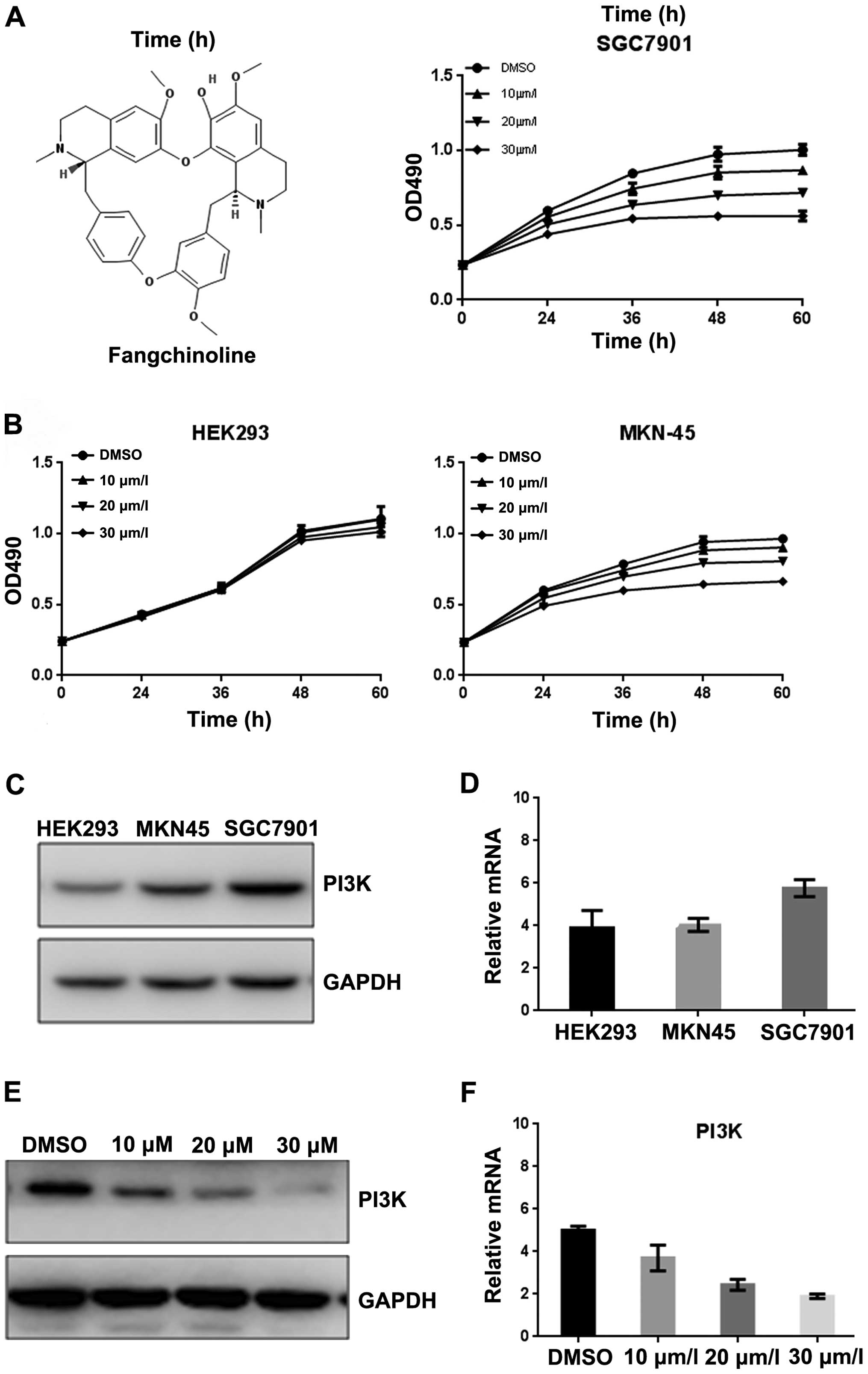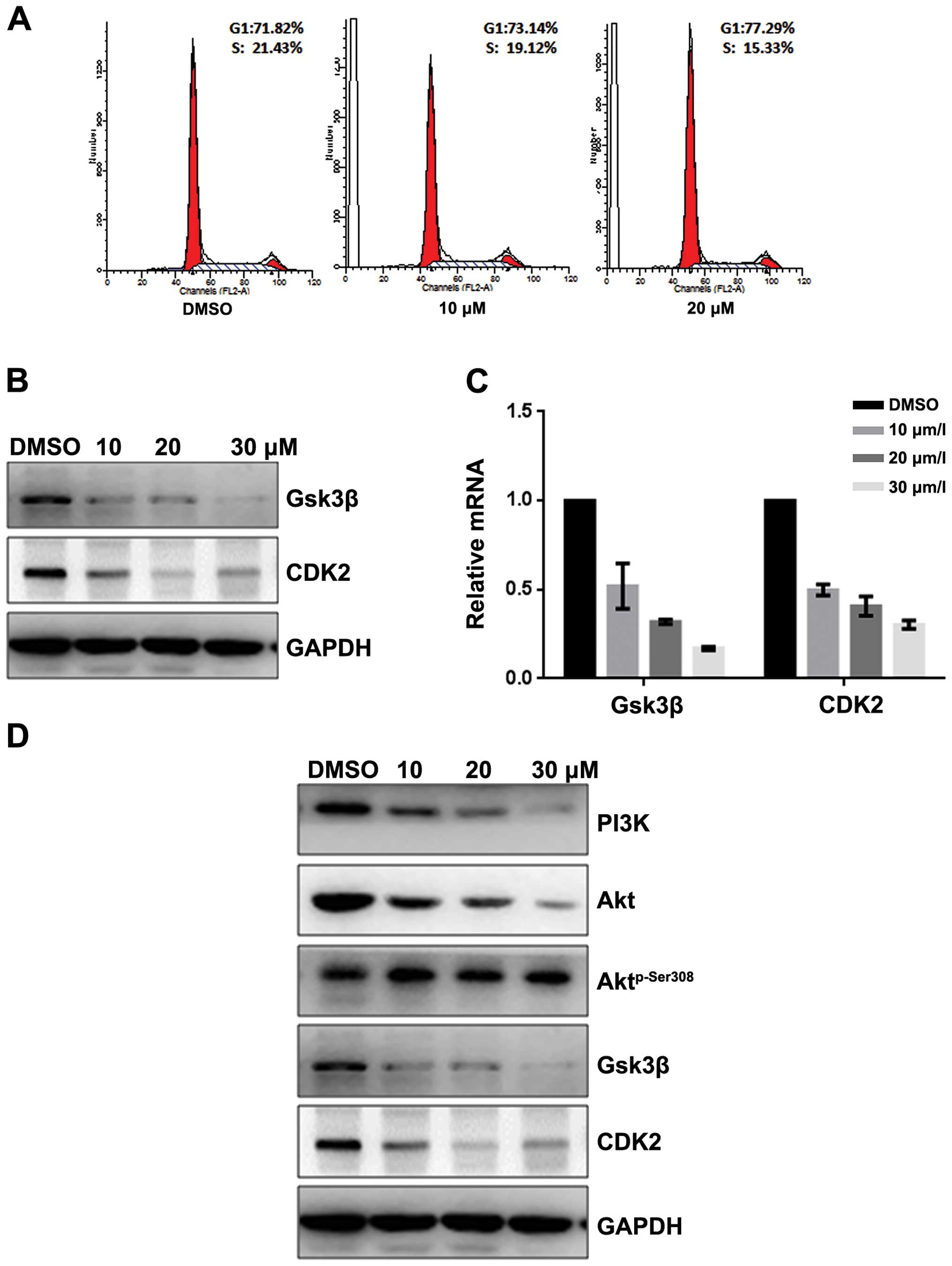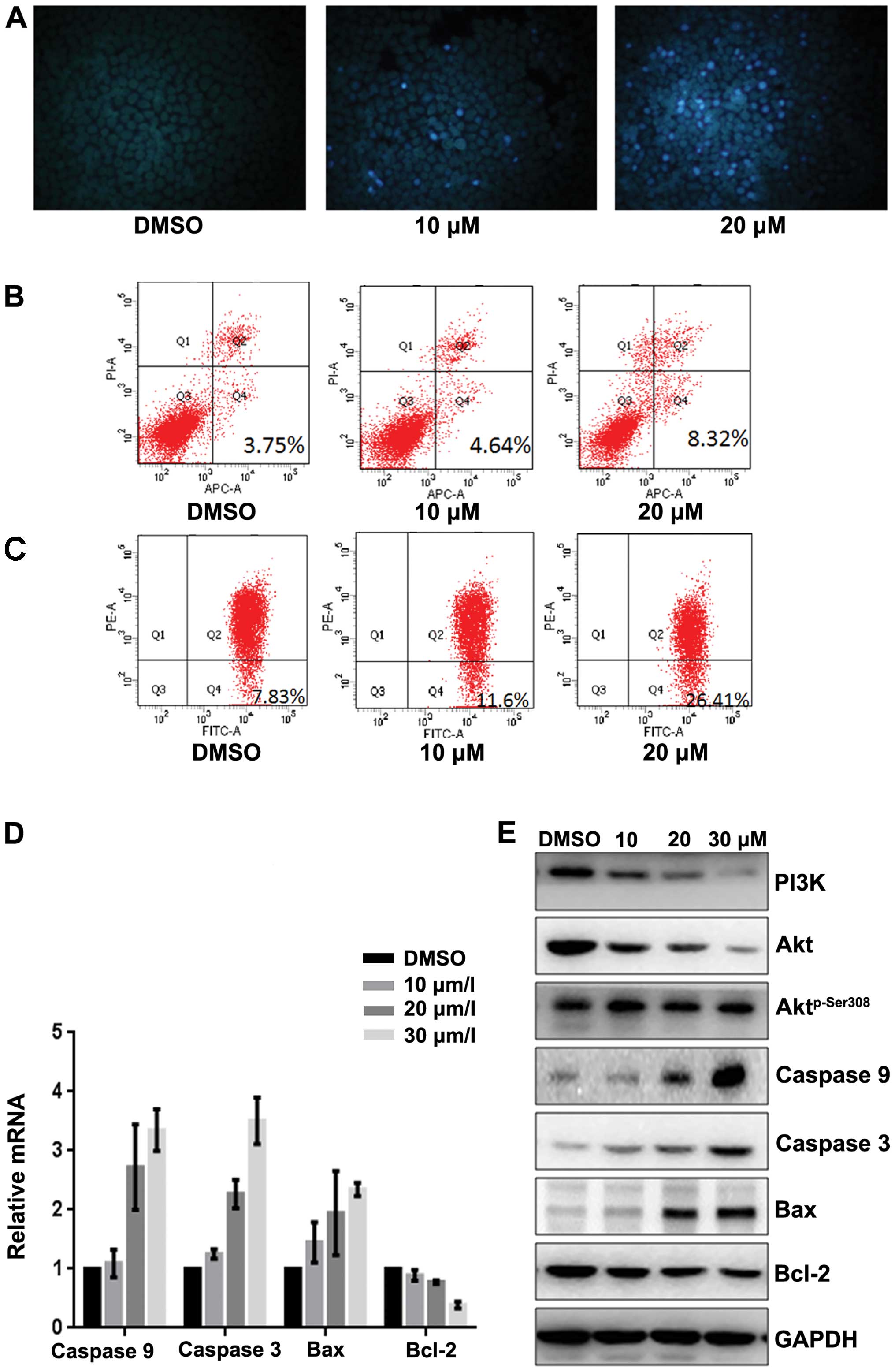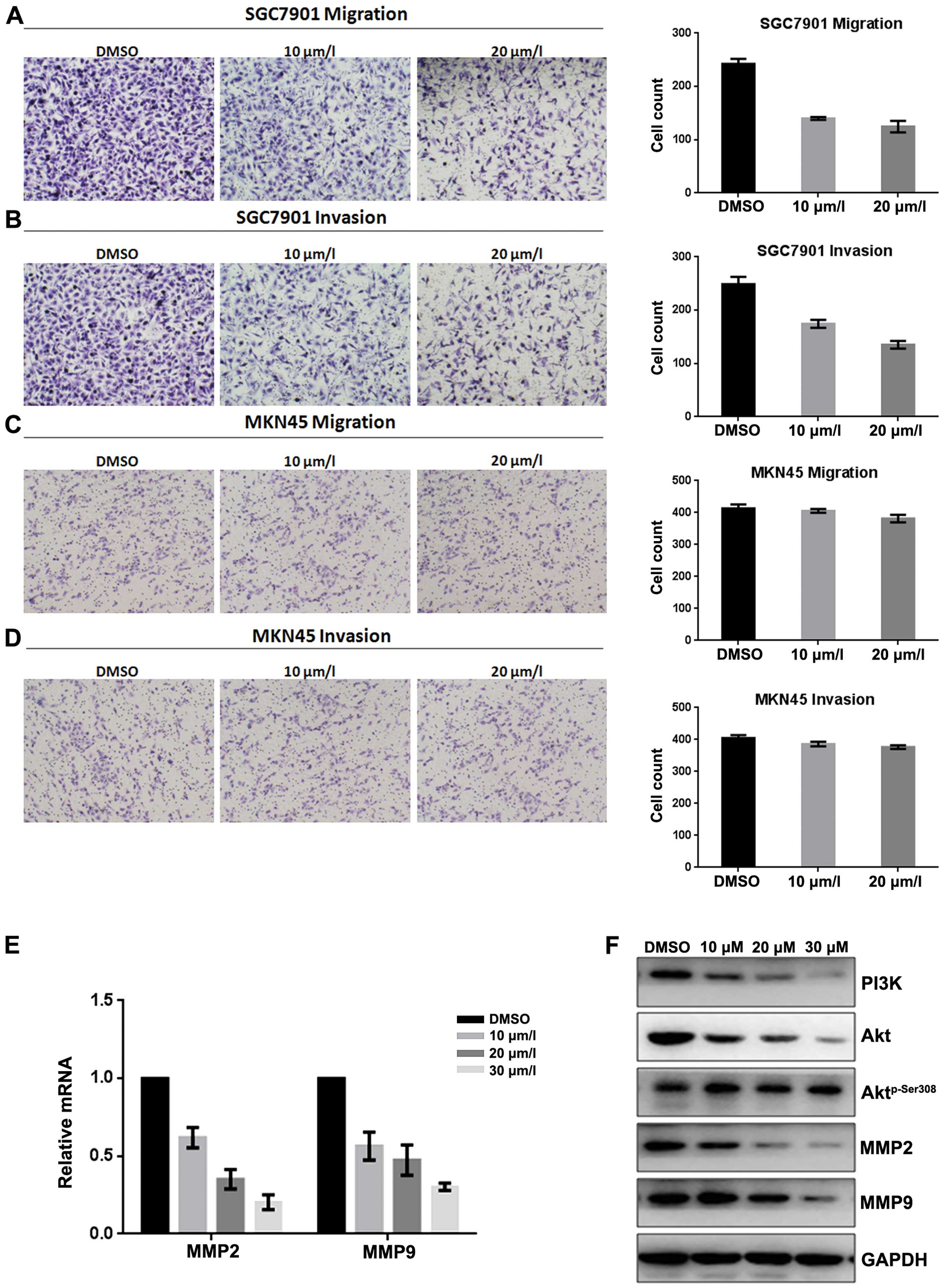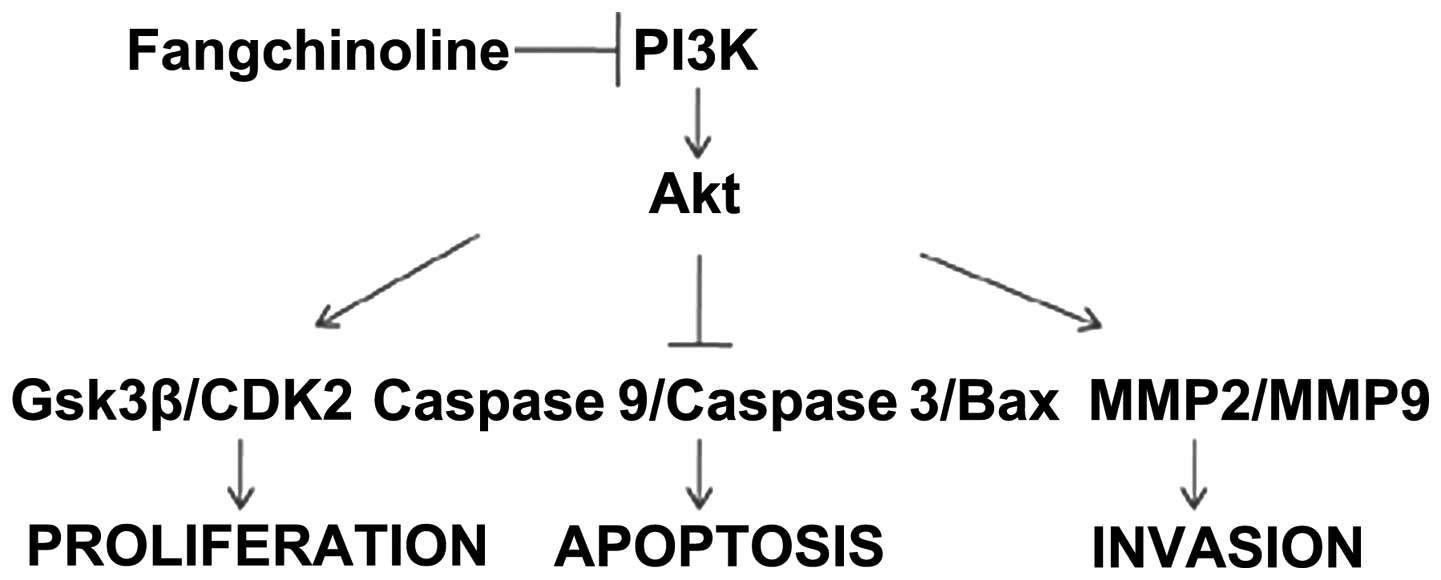Fangchinoline targets PI3K and suppresses PI3K/AKT signaling pathway in SGC7901 cells
Retraction in: /10.3892/ijo.2023.5547
- Authors:
- Published online on: April 9, 2015 https://doi.org/10.3892/ijo.2015.2959
- Pages: 2355-2363
-
Copyright: © Tian et al. This is an open access article distributed under the terms of Creative Commons Attribution License [CC BY_NC 3.0].
Abstract
Introduction
Gastric cancer is the second most common form of cancer in the world. Therapeutic surgical techniques are improving and some chemotherapeutic regimens are available, but the outcomes of patients with high grade gastric cancer are usually poor (1).
Activation of PI3K generates second messenger PIP3. The colocalization of PIP3 with Akt and PDK1 invokes the phosphorylation of Akt Ser308 (2). The PI3K/AKT signaling pathway is an important part of intracellular signal transduction, cell proliferation, differentiation, apoptosis and migration. The PI3K/AKT signaling pathway has been implicated in a variety of tumor growth and metastasis (3). For example, oncogenic activation of PI3K/Akt molecules enhances cell proliferation by increasing Cyclin D1 levels (4–6). It is well known that the aberrant expression of Cyclin D1 and CDK4 proteins is involved in the proliferation of CRC cells (7). Suppression of PI3K/Akt leads to the blockade of cell proliferation and demonstrates the importance of these signaling cascades in the control of both cell cycle progression and cell growth during cancer development (8). Therefore, using the PI3K inhibitors in cancer therapy is considered to be a very promising solution to tumor treatment. Recent years have seen an explosion in the number of phosphoinositide 3-kinase (PI3K) pathway inhibitors under clinical investigation (9).
Fangchinoline is the main chemical constituent of Stephania tetrandra S. Moore, which has been shown to possess a wide range of pharmacological activities (10), including inhibition of histamine release and antihypertensive activities (11,12), antiinflammatory effects (13–15), antiplatelet aggregation activities (16), antihyperglycemic actions (17,18), neuroprotective effects (19), and antioxidant and radical scavenging activities (20,21). Another pharmacological activity is a wide spectrum of antitumor activity in various cancer cells, the potent antitumor activity of tetrandrine has been extensively investigated with its proposed mechanism of inducing G1/S and G2/M arrest and stimulating apoptotic cell death (22–24). However, there are not many reports of the antitumor activity of fangchinoline and its underlying mechanism. Experiments have showed that fangchinoline inhibits cell proliferation via Akt/Gsk3β/Cyclin D1 signaling induces apoptosis in breast cancer cell lines and induces autophagic cell death via p53/sestrin2/AMPK signaling in human hepatocellular carcinoma cells (25–28). Here we report that fangchinoline effectively suppressed the proliferation and invasion of gastric cancer cells SGC7901 and BGC823 and promoted their early apoptosis. Importantly, we provide a novel mechanism that fangchinoline targets PI3K, which promotes tumor cell survival and invasion by suppressing the phosphorylation of Akt (Ser308). Our evidence suggests that fangchinoline is a potential anticancer drug as the natural inhibitor of PI3K.
Materials and methods
Cell culture
Human gastric cancer cell lines MKN45, SGC7901 and HEK293 cells (as the control) were cultured in DMEM (Invitrogen) supplemented with 10% fetal calf serum (Invitrogen) at 37°C in incubator with humidified atmosphere of 5% CO2 and 95% air.
MTT assays
Human cancer cells (1×104/well) were plated in 0.1 ml of the medium containing 10% FBS in 96-well plates; 24 h later, the medium was removed and replaced with 0.1 ml medium containing the indicated concentrations of fangchinoline and incubated for 24, 36, 48 and 60 h. At the end of the incubation, the capability of cellular proliferation was measured by the modified tetrazolium salt-3-(4-5 dimethylthiazol-2-yl)-2-5-diphenyltetrazolium bromide (MTT) assay. For this, 0.01 ml of MTT solution (5 mg/ml in PBS) was added to each well. After a 4-h incubation at 37°C, medium was replaced by 0.15 ml DMSO. After 15-min incubation at 37°C, the optical densities at 490 nm were measured using a Microplate Reader (Bio-Rad).
Cell-cycle analysis by flow cytometry
SGC7901 cells were incubated with the indicated concentrations of fangchinoline for 24 h. After incubation, cells were collected, washed with PBS and then suspended in a staining buffer (10 μg/ml propidium iodide, 0.5% Tween-20, 0.1% RNase in PBS). The cells were analyzed using a FACS Vantage flow cytometer with the CellQuest acquisition and analysis software program (Becton-Dickinson Co., San Jose, CA, USA). Gating was set to exclude cell debris, doublets and clumps.
Cell migration and invasion assay
Migration and invasion assays were performed using modified boyden chambers with polycarbonate nucleopore membrane. Precoated filters (6.5 mm in diameter, 8-μm pore size, Matrigel 100 μg/cm2) were rehydrated with 100 μl medium. Then, 1×105 cells in 100 μl serum-free DMEM supplemented with 0.1% bovine serum albumin were placed in the upper part of each chamber, whereas the lower compartments were filled with 600 μl DMEM containing 10% serum. After incubation for 18 h at 37°C, non-invaded cells were removed from the upper surface of the filter with a cotton swab, and the invaded cells on the lower surface of the filter were fixed, stained, photographed and counted under high-power magnification.
Cell apoptosis
Following Annexin V-V-FITC apoptosis detection kit instructions, the specific steps were: cells were washed twice with cold PBS, then re-suspended with binding buffer cells at a concentration of 1×106 cells/ml. Adding 5 μl of Annexin V-FITC and 10 μl of PI. Cells were incubated in the dark, at room temperature, for 15 min. Then, 400 μl binding buffer was added to each tube and the apoptosis rate was measured by flow cytometry within 1 h.
Hoechst 33258 staining
SGC7901 cells were incubated with the indicated concentrations of fangchinoline for 24 h. After incubation, cells were fixed with 4% polyoxymethylene, then washed twice with PBS, incubated with 10 μg/ml Hoechst 33258 for 5 min at room temperature, then washed with PBS 3 times. Cells were observed with fluorescence microscope.
Mitochondrial membrane potential
Cells (1×105) were cultured in 6-well plates for the assay, then collected, centrifuged and re-suspended in 0.5 ml DMEM medium. The cells were washed twice in staining buffer and then incubated in 0.5 ml JC-1 staining buffer, at room temperature, in the dark. Flow cytometry was used to determine the fluorescence intensity of the red/green ratio semi-quantitatively.
Reverse transcription and quantitative real-time PCR
Total cellular RNA from DMSO and fangchinoline treated SGC7901 cells were extracted after 24 h using TRIzol (Invitrogen) according to the manufacturer’s protocol. One microgram of total RNA was reverse transcribed to cDNA in a total volume of 20 μl system using a RT reaction kit (Promega). Real-time PCR was performed using an Mx 3000P real-time PCR system (Applied Biosystems) according to the manufacturer’s instructions and SYBR Premix Ex Taq (Takara) as a DNA-specific fluorescent dye. PCR was carried out for 50 cycles of 95°C for 10 sec and 60°C for 30 sec. Primer sequences for detection of mRNA expression were synthesized (Table I). All the reactions were repeated at least three times. Gene expression levels were calculated relative to the housekeeping β-actin by using Stratagene Mx 3000P software.
Western blot analyses
To determine the expression of protein, whole cell extracts (lysate) were prepared from 1×106 cells in lysis buffer (20 mM Tris pH 7.4, 250 mM sodium chloride, 0.1% Triton-X-100, 2 mM EDTA, 10 μg/ml leupeptin, 10 μg/ml aprotinin, 0.5 mM phenylmethylsulfonyl fluoride, 4 mM sodium orthovanadate and 1 mM DTT), and 60 μg of the protein was resolved on 10% SDS-polyacrylamide gels. After electrophoresis, the proteins were eletrotransferred to nitrocellulose filters, the membrane (Amersham) was blocked with 5% non-fat dry milk in TBS-T (20 mM Tris, pH 7.6, 137 mM NaCl, 0.05% Tween-20) for 1 h at room temperature, and the proteins were probed with specific antibodies-Gsk3β, CDK2, MMP2, MMP9 (Bioworld), Akt, phospho-Akt (Ser308) (Santa Cruz), caspase-3, caspase-9, Bax and Bcl-2 (Neomarker). To assure equal loading, gels were stripped and reprobed with antibodies against GAPDH (Kangchen Bio-tech Inc., Shanghai, China). All PVDF membranes were detected by chemiluminescence (ECL, Pierce Technology).
Results
Fangchinoline inhibits the the expression of PI3K
MKN45, SGC7901 and HEK293 cells were used to detect the inhibitory effect of fangchinoline on growth of these cells. As shown in MTT assay, fangchinoline treatment inhibited the proliferation of SGC7901 cells in a concentration-dependent manner but have little effect on other cells (Fig. 1B). Since proteins regulating signaling through the phosphatidylinositol 3-kinase (PI3K)/Akt pathway is frequently altered in human cancer, including gastric cancer (29), the expression level of PI3K in gastric cancer cell lines was examined. Interestingly, the protein and mRNA levels of PI3K were dramatically higher in SGC7901 cells than that in MKN45 cells and HEK-293 cells (Fig. 1C and D) indicating PI3K might be targeted by fangchinoline and be involved in fangchinoline-induced growth inhibition of gastric cancer cells. Furthermore, we examined whether fangchinoline inhibited the PI3K in SGC7901 cells, and found that Fangchinoline at 20 μmol/l markedly inhibited the level of PI3K (Fig. 1E and F).
Fangchinoline inhibits the proliferation of SGC7901 by inhibiting PI3K/Akt pathway
To further investigate the mechanisms of fangchinoline inhibition of growth of gastric cancer, the SGC7901 cells were exposed to various concentrations of fangchinoline for 24 h, and then cell cycle analysis was performed. Fangchinoline prominently induced a dose-dependent increase in the percentage of cells in G1 phase and decrease in S phase compared with the control (Fig. 2A), indicating that fangchinoline arrested SGC7901 cells at the G1 phase of the cell cycle. Since Gsk3β and CDK2 are key regulators in the G1 phase of the cell cycle, we examined the indicated regulator expression level in fangchinoline-treated cells. Western blot analysis showed that exposure of SGC7901 to 10/20/30 μmol/l fangchinoline for 48 h dramatically decreased protein expression of Gsk3β and CDK2 (Fig. 2B), indicating fangchinoline arrests cells at G1 phase and then suppresses cell growth via downregulated Gsk3β and CDK2. Furthermore, real-time RT-PCR showed that expression of Gsk3β and CDK2 in SGC7901 was downregulated at mRNA level after exposure to fangchinoline (Fig. 2C). Western blot analysis showed that Aktp-Ser308 was downregulated in a dose-dependent manner without affecting its total expression (Fig. 2D).
Fangchinoline induces apoptosis of SGC7901 by inhibiting the PI3K/Akt pathway
To evaluate whether fangchinoline induces apoptosis of SGC7901 cells, we detected the apoptosis rate by Hoechst 33258 staining and AV-PI. Hoechst 33258 staining was performed to observe the fangchinoline-induced apoptotic nucleus of SGC7901 cells. Condensed chromatin was observed in fangchinoline-treated SGC7901 cells (Fig. 3A). By Annexin V-FITC staining, the fangchinoline-induced SGC7901 cell apoptosis was increased compared to that of the control cells (Fig. 3B). The loss of mitochondrial membrane potential (ΔΨm) is regarded as one of the early events in the apoptotic pathway, which can trigger the release of cytochrome c and other apoptosis related molecules after induction by various stimuli. To detect the change of the mitochondrial membrane potential, JC-1 was used to stain the cells and then analyzed them through flow cytometry. Results showed that the number of cells with loss of ΔΨm increased after treatment with fangchinoline (Fig. 3C). Then real-time RT-PCR showed that expression of caspase-3, caspase-9 and Bax in SGC7901 were upregulated at mRNA level and Bcl-2 was downregulated at mRNA level after exposure to fangchinoline (Fig. 3D). Furthermore the expression of apoptosis regulators was examined by western blot analysis. The expression of Bcl-2 and PI3K was obviously decreased and the levels of caspase-3, caspase-9 and Bax were increased in fangchinoline treated SGC7901 cells, and Aktp-Ser308 was dramatically downregulated without changing the expression of Akt (Fig. 3E).
Fangchinoline represses the migratory and invasive potential of SGC7901 by inhibiting the PI3K/Akt pathway
Inhibitory effect of fangchinoline on migration and invasion of MKN45 and SGC7901 cells were analyzed by Τranswell assay (with or without Μatrigel). Results showed that fangchinoline significantly decreased invasion and migration potential of gastric cancer SGC7901 cells (Fig. 4A and B) in a dose-dependent manner, but weakly decreased invasion and migration potential of MKN45 cells (Fig. 4C and D). Real-time RT-PCR showed that expression of MMP2 and MMP9 in SGC7901 was downregulated at mRNA level after exposure to fangchinoline (Fig. 4E). Western blot analysis showed that exposure of SGC7901 to fangchinoline (10/20/30 μmol/l) for 48 h dramatically decreased levels of MMP2, MMP9, PI3K and Aktp-Ser308 but had little effect on Akt (Fig. 4F). These results indicated that fangchinoline effectively suppressed proliferation and invasion of SGC7901 by inhibiting the PI3K/Akt pathway (Fig. 5).
Discussion
Fangchinoline inhibits cell proliferation and induces apoptosis as an antitumor agent in several cancer cell lines, such as MDA-MB-231 and HepG2 cells (25–28). However, the effects of fangchinoline on gastric cancer cells have not been previously reported. Our data show fangchinoline treatment inhibited the proliferation, migration, and invasion of SGC7901 cells in a concentration-dependent manner but had little effect on MKN45 cell lines or the control cell line HEK293. In elucidating the mechanism, we found high expression of PI3K in SGC7901 cell lines but only slight expression in MKN45 cells and the control HEK293 cells. Interestingly, we found fangchinoline could suppress the PI3K in SGC7901 cells, which implies that fangchinoline targets PI3K in tumor cells that highly express PI3K and inhibits their proliferation, migration, and invasion.
PI3K is considered as a key regulator in cancer cell signaling. It has been reported that the inhibition of PI3K is important in tumor treatment. LY294002 can effectively change the microvascular permeability, reducing fluid pressure in the tumor stroma (30). PI-103 can not only inhibit PI3K, but it also inhibits mTOR and DNA-dependent protein kinase, a feature that has been used in a variety of in vivo efficacy models, and can even have a certain effect on glioblastomas (31). In some joint drug tests, ATP-competitive inhibition of PI3K showed good tolerability and higher activity, which can improve the efficacy of other anticancer drugs (32). In our study, PI3K level was markedly decreased at 20 μmol/l concentration of fangchinoline in SGC7901. Taken together, these results indicated fangchinoline acted as a novel inhibitor of PI3K and suppressed SGC7901 cell line proliferation via PI3K.
It has been recognized that control of cell cycle progression in cancer cells is an effective strategy to inhibit tumor growth (33,34). The phosphoinositide 3-kinase (PI3K)/Akt is a fundamental signaling pathway that mediates several cellular processes, including cell proliferation, growth, survival, and motility (35). Our data showed that fangchinoline arrested SGC7901 cells during the G1 phase by decreasing the protein levels of Gsk3β, CDK2, which act as key regulators of the G1-S check-point. We also found that fangchinoline promotes SGC7901 apoptosis by decreasing Bcl-2 level and increasing caspase-3, caspase-9 expression. At the same time, Gsk3β and caspase-3 are the downstream proteins of PI3K/Akt pathway (36–38). All of these observations are consistent with the finding that fangchinoline SGC7901 growth adjustment occurs in the PI3K/Akt pathways.
In addition to the effect on cell proliferation, we demonstrated inhibition of fangchinoline on migration and invasion of gastric cancer cells. One of the key steps in cancer invasion and metastasis is the degradation of the extracellular matrix. MMP2 has been demonstrated to play important roles in this process (39,40). Matrix metalloproteinases (MMPs) can affect tumor invasion and metastasis through the PI3K/Akt pathway by inducing the expression of MMP2, which plays an important role in tumor cell migration (41). Our results showed that fangchinoline significantly suppressed the migratory and invasive ability of SGC7901 in parallel with downregulation of MMP9 and MMP2. Therefore, it is reasonable to speculate that fangchinoline inhibits cell invasion and metastasis by the PI3K/Akt/MMP2/MMP9 pathway.
In conclusion, fangchinoline was identified as capable of inhibiting PI3K and its downstream signaling pathways and suppressing PI3K-mediated SGC7901 behavior including growth, migration, and invasion. Further testing in experimental models in vivo is warranted. The results presented in our current study add to the scope of the exploration and application of PI3K inhibitors and may offer a novel therapeutic strategy for advanced metastatic gastric cancer.
References
|
Corso S, Ghiso E, Cepero V, Sierra JR, Migliore C, Bertotti A, Trusolino L, Comoglio PM and Giordano S: Activation of HER family members in gastric carcinoma cells mediates resistance to MET inhibition. Mol Cancer. 9:1212010. View Article : Google Scholar : PubMed/NCBI | |
|
Solit DB, Basso AD, Olshen AB, Scher HI and Rosen N: Inhibition of heat shock protein 90 function down-regulates Akt kinase and sensitizes tumors to Taxol. Cancer Res. 63:2139–2144. 2003.PubMed/NCBI | |
|
Kazlauskas A and Cooper JA: Phosphorylation of the PDGF receptor beta subunit creates a tight binding site for phosphatidylinositol 3 kinase. EMBO J. 9:3279–3286. 1990.PubMed/NCBI | |
|
Chiang EP, Tsai SY, Kuo YH, Pai MH, Chiu HL, Rodriguez RL and Tang FY: Caffeic acid derivatives inhibit the growth of colon cancer: Involvement of the PI3-K/Akt and AMPK signaling pathways. PLoS One. 9:e996312014. View Article : Google Scholar : PubMed/NCBI | |
|
Gustin JP, Karakas B, Weiss MB, Abukhdeir AM, Lauring J, Garay JP, Cosgrove D, Tamaki A, Konishi H, Konishi Y, et al: Knockin of mutant PIK3CA activates multiple oncogenic pathways. Proc Natl Acad Sci USA. 106:2835–2840. 2009. View Article : Google Scholar : PubMed/NCBI | |
|
Kang S, Bader AG and Vogt PK: Phosphatidylinositol 3-kinase mutations identified in human cancer are oncogenic. Proc Natl Acad Sci USA. 102:802–807. 2005. View Article : Google Scholar : PubMed/NCBI | |
|
Wang QS, Papanikolaou A, Sabourin CL and Rosenberg DW: Altered expression of cyclin D1 and cyclin-dependent kinase 4 in azoxymethane-induced mouse colon tumorigenesis. Carcinogenesis. 19:2001–2006. 1998. View Article : Google Scholar : PubMed/NCBI | |
|
Halilovic E, She QB, Ye Q, Pagliarini R, Sellers WR, Solit DB and Rosen N: PIK3CA mutation uncouples tumor growth and cyclin D1 regulation from MEK/ERK and mutant KRAS signaling. Cancer Res. 70:6804–6814. 2010. View Article : Google Scholar : PubMed/NCBI | |
|
Dienstmann R, Rodon J, Serra V and Tabernero J: Picking the point of inhibition: A comparative review of PI3K/AKT/mTOR pathway inhibitors. Mol Cancer Ther. 13:1021–1031. 2014. View Article : Google Scholar : PubMed/NCBI | |
|
Wang Y, Chen J, Wang L, Huang Y, Leng Y and Wang G: Fangchinoline induces G0/G1 arrest by modulating the expression of CDKN1A and CCND2 in K562 human chronic myelogenous leukemia cells. Exp Ther Med. 5:1105–1112. 2013.PubMed/NCBI | |
|
Nakamura K, Tsuchiya S, Sugimoto Y, Sugimura Y and Yamada Y: Histamine release inhibition activity of bisbenzylisoquinoline alkaloids. Planta Med. 58:505–508. 1992. View Article : Google Scholar : PubMed/NCBI | |
|
Kim HS, Zhang YH, Oh KW and Ahn HY: Vasodilating and hypotensive effects of fangchinoline and tetrandrine on the rat aorta and the stroke-prone spontaneously hypertensive rat. J Ethnopharmacol. 58:117–123. 1997. View Article : Google Scholar : PubMed/NCBI | |
|
Hristova M and Istatkova R: Complement-mediated antiinflammatory effect of bisbenzylisoquinoline alkaloid fangchinoline. Phytomedicine. 6:357–362. 1999. View Article : Google Scholar | |
|
Choi HS, Kim HS, Min KR, Kim Y, Lim HK, Chang YK and Chung MW: Anti-inflammatory effects of fangchinoline and tetrandrine. J Ethnopharmacol. 69:173–179. 2000. View Article : Google Scholar : PubMed/NCBI | |
|
Shen YC, Chou CJ, Chiou WF and Chen CF: Anti-inflammatory effects of the partially purified extract of radix Stephaniae tetrandrae: Comparative studies of its active principles tetrandrine and fangchinoline on human polymorphonuclear leukocyte functions. Mol Pharmacol. 60:1083–1090. 2001.PubMed/NCBI | |
|
Kim HS, Zhang YH and Yun YP: Effects of tetrandrine and fangchinoline on experimental thrombosis in mice and human platelet aggregation. Planta Med. 65:135–138. 1999. View Article : Google Scholar : PubMed/NCBI | |
|
Tsutsumi T, Kobayashi S, Liu YY and Kontani H: Antihyperglycemic effect of fangchinoline isolated from Stephania tetrandra Radix in streptozotocin-diabetic mice. Biol Pharm Bull. 26:313–317. 2003. View Article : Google Scholar : PubMed/NCBI | |
|
Ma W, Nomura M, Takahashi-Nishioka T and Kobayashi S: Combined effects of fangchinoline from Stephania tetrandra Radix and formononetin and calycosin from Astragalus membranaceus Radix on hyperglycemia and hypoinsulinemia in streptozotocin-diabetic mice. Biol Pharm Bull. 30:2079–2083. 2007. View Article : Google Scholar : PubMed/NCBI | |
|
Lin TY, Lu CW, Tien LT, Chuang SH, Wang YR, Chang WH and Wang SJ: Fangchinoline inhibits glutamate release from rat cerebral cortex nerve terminals (synaptosomes). Neurochem Int. 54:506–512. 2009. View Article : Google Scholar : PubMed/NCBI | |
|
Gülçin I, Elias R, Gepdiremen A, Chea A and Topal F: Antioxidant activity of bisbenzylisoquinoline alkaloids from Stephania rotunda: Cepharanthine and fangchinoline. J Enzyme Inhib Med Chem. 25:44–53. 2010. View Article : Google Scholar | |
|
Sekiya N, Hikiami H, Yokoyama K, Kouta K, Sakakibara I, Shimada Y and Terasawa K: Inhibitory effects of Stephania tetrandra S. Moore on free radical-induced lysis of rat red blood cells. Biol Pharm Bull. 28:667–670. 2005. View Article : Google Scholar : PubMed/NCBI | |
|
Zhang YH, Fang LH and Ku BS: Fangchinoline inhibits rat aortic vascular smooth muscle cell proliferation and cell cycle progression through inhibition of ERK1/2 activation and c-fos expression. Biochem Pharmacol. 66:1853–1860. 2003. View Article : Google Scholar : PubMed/NCBI | |
|
Meng LH, Zhang H, Hayward L, Takemura H, Shao RG and Pommier Y: Tetrandrine induces early G1 arrest in human colon carcinoma cells by down-regulating the activity and inducing the degradation of G1-S-specific cyclin-dependent kinases and by inducing p53 and p21Cip1. Cancer Res. 64:9086–9092. 2004. View Article : Google Scholar : PubMed/NCBI | |
|
Sun X, Xu R, Deng Y, Cheng H, Ma J, Ji J and Zhou Y: Effects of tetrandrine on apoptosis and radiosensitivity of nasopharyngeal carcinoma cell line CNE. Acta Biochim Biophys Sin (Shanghai). 39:869–878. 2007. View Article : Google Scholar | |
|
Wang N, Pan W, Zhu M, Zhang M, Hao X, Liang G and Feng Y: Fangchinoline induces autophagic cell death via p53/sestrin2/AMPK signalling in human hepatocellular carcinoma cells. Br J Pharmacol. 164(2b): 731–742. 2011. View Article : Google Scholar : PubMed/NCBI | |
|
Wang CD, Yuan CF, Bu YQ, Wu XM, Wan JY, Zhang L, Hu N, Liu XJ, Zu Y, Liu GL, et al: Fangchinoline inhibits cell proliferation via Akt/GSK-3beta/cyclin D1 signaling and induces apoptosis in MDA-MB-231 breast cancer cells. Asian Pac J Cancer Prev. 15:769–773. 2014. View Article : Google Scholar | |
|
Xing Z, Zhang Y, Zhang X, Yang Y, Ma Y and Pang D: Fangchinoline induces G1 arrest in breast cancer cells through cell-cycle regulation. Phytother Res. 27:1790–1794. 2013. View Article : Google Scholar : PubMed/NCBI | |
|
Xing ZB, Yao L, Zhang GQ, Zhang XY, Zhang YX and Pang D: Fangchinoline inhibits breast adenocarcinoma proliferation by inducing apoptosis. Chem Pharm Bull (Tokyo). 59:1476–1480. 2011. View Article : Google Scholar | |
|
Sun HW, Tong SL, He J, Wang Q, Zou L, Ma SJ, Tan HY, Luo JF and Wu HX: RhoA and RhoC -siRNA inhibit the proliferation and invasiveness activity of human gastric carcinoma by Rho/PI3K/Akt pathway. World J Gastroenterol. 13:3517–3522. 2007. View Article : Google Scholar : PubMed/NCBI | |
|
Schnell O, Krebs B, Wagner E, Romagna A, Beer AJ, Grau SJ, Thon N, Goetz C, Kretzschmar HA, Tonn JC, et al: Expression of integrin alphavbeta3 in gliomas correlates with tumor grade and is not restricted to tumor vasculature. Brain Pathol. 18:378–386. 2008. View Article : Google Scholar : PubMed/NCBI | |
|
Raynaud FI, Eccles S, Clarke PA, Hayes A, Nutley B, Alix S, Henley A, Di-Stefano F, Ahmad Z, Guillard S, et al: Pharmacologic characterization of a potent inhibitor of class I phosphatidylinositide 3-kinases. Cancer Res. 67:5840–5850. 2007. View Article : Google Scholar : PubMed/NCBI | |
|
Leung E, Kim JE, Rewcastle GW, Finlay GJ and Baguley BC: Comparison of the effects of the PI3K/mTOR inhibitors NVP-BEZ235 and GSK2126458 on tamoxifen-resistant breast cancer cells. Cancer Biol Ther. 11:938–946. 2011. View Article : Google Scholar : PubMed/NCBI | |
|
Pavletich NP: Mechanisms of cyclin-dependent kinase regulation: Structures of Cdks, their cyclin activators, and Cip and INK4 inhibitors. J Mol Biol. 287:821–828. 1999. View Article : Google Scholar : PubMed/NCBI | |
|
Graña X and Reddy EP: Cell cycle control in mammalian cells: Role of cyclins, cyclin dependent kinases (CDKs), growth suppressor genes and cyclin-dependent kinase inhibitors (CKIs). Oncogene. 11:211–219. 1995.PubMed/NCBI | |
|
Prasad R, Vaid M and Katiyar SK: Grape proanthocyanidin inhibit pancreatic cancer cell growth in vitro and in vivo through induction of apoptosis and by targeting the PI3K/Akt pathway. PLoS One. 7:e430642012. View Article : Google Scholar : PubMed/NCBI | |
|
Gan B, Yoo Y and Guan JL: Association of focal adhesion kinase with tuberous sclerosis complex 2 in the regulation of s6 kinase activation and cell growth. J Biol Chem. 281:37321–37329. 2006. View Article : Google Scholar : PubMed/NCBI | |
|
Schlaepfer DD and Hunter T: Signal transduction from the extracellular matrix - a role for the focal adhesion protein-tyrosine kinase FAK. Cell Struct Funct. 21:445–450. 1996. View Article : Google Scholar : PubMed/NCBI | |
|
Zhao J and Guan JL: Signal transduction by focal adhesion kinase in cancer. Cancer Metastasis Rev. 28:35–49. 2009. View Article : Google Scholar : PubMed/NCBI | |
|
Hara T, Miyazaki H, Lee A, Tran CP and Reiter RE: Androgen receptor and invasion in prostate cancer. Cancer Res. 68:1128–1135. 2008. View Article : Google Scholar : PubMed/NCBI | |
|
Libra M, Scalisi A, Vella N, Clementi S, Sorio R, Stivala F, Spandidos DA and Mazzarino C: Uterine cervical carcinoma: Role of matrix metalloproteinases (Review). Int J Oncol. 34:897–903. 2009. View Article : Google Scholar : PubMed/NCBI | |
|
Kanaki T, Bujo H, Mori S, Yanjuan Z, Takahashi K, Yokote K, Morisaki N and Saito Y: Functional analysis of aortic endothelial cells expressing mutant PDGF receptors with respect to expression of matrix metalloproteinase-3. Biochem Biophys Res Commun. 294:231–237. 2002. View Article : Google Scholar : PubMed/NCBI |



